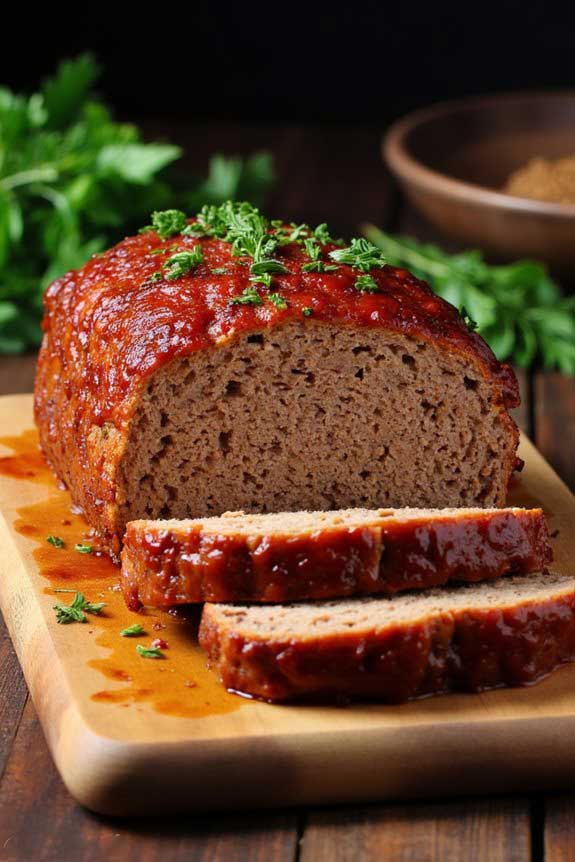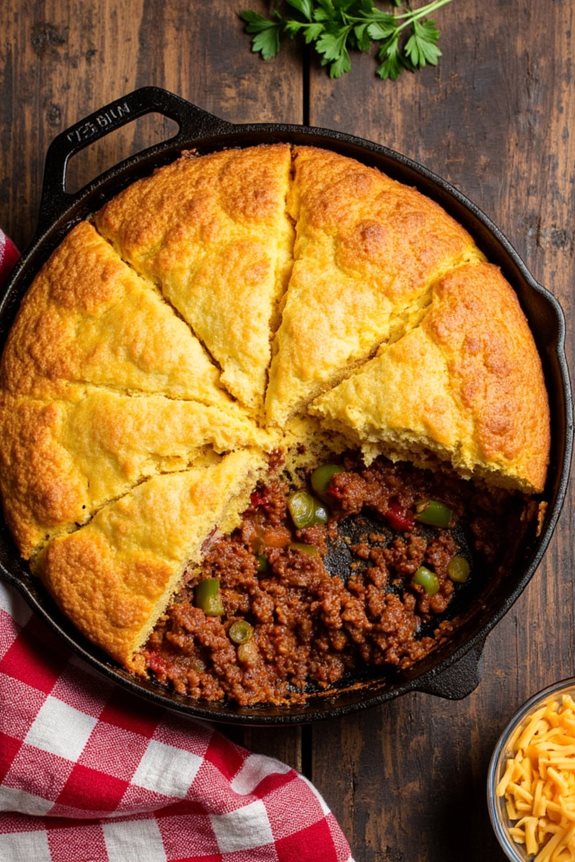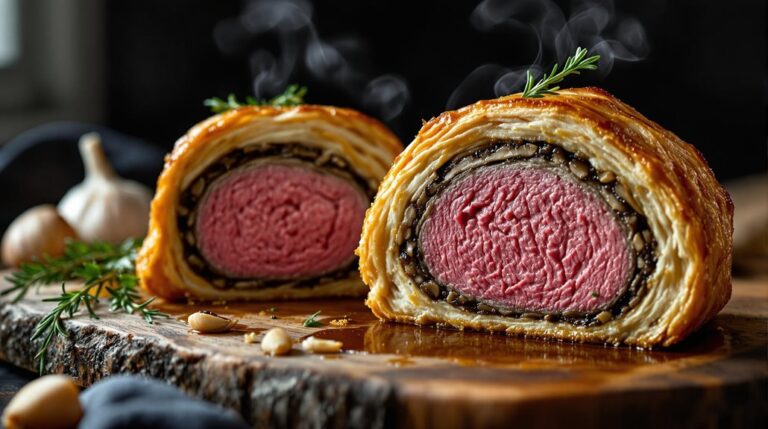I’ve been searching for the perfect meatloaf recipe for years, and trust me, this one’s a keeper.
There’s something magical about that first bite of a well-made meatloaf—tender, juicy, packed with flavor that brings back childhood memories.
My Grandma’s recipe strikes that perfect balance between savory and comforting, with a few secret ingredients that make all the difference.
Wonder what makes this version stand out from all those dry, flavorless meatloaves you’ve tried before? The answer might surprise you.
Why You’ll Love This Meatloaf
- Comfort food at its finest – This Wisconsin classic delivers that warm, nostalgic feeling you crave, transforming an ordinary dinner into something truly special that wraps you in memories.
- Perfect texture every time – The savory herbs and carefully balanced moisture create a meatloaf that’s never dry, never mushy, just perfectly tender and flavorful.
- Kid-approved and family-friendly – Even picky eaters clean their plates when this hits the table, making dinnertime stress-free for busy parents.
- Incredible versatility – Enjoy it hot for dinner, then savor the leftovers the next day nestled between crusty bread with mayo for an amazing sandwich.
- Budget-friendly comfort – Using simple, locally-sourced ingredients, this recipe delivers maximum flavor and satisfaction without breaking the bank.
What Ingredients are in Meatloaf?
My grandmother’s meatloaf recipe brings together simple, hearty ingredients that showcase the best of Wisconsin’s local bounty.
This isn’t some fancy, complicated dish—it’s honest comfort food that relies on quality ingredients rather than culinary tricks.
After years of perfecting this recipe, I’ve found that sourcing local ground beef from Wisconsin farms makes all the difference in both flavor and texture.
Ready to gather what you need for this family favorite?
- 2 pounds fresh ground beef (preferably grass-fed from a local Wisconsin farm)
- 1 cup breadcrumbs (I often use leftover sourdough from the bakery down the street)
- 2 large eggs from a local farm
- 1 medium onion, finely diced
- 1 bell pepper, finely diced
- 3 cloves garlic, minced
- 2 tablespoons Worcestershire sauce
- 1/4 cup Wisconsin-made ketchup, plus extra for topping
- 1 tablespoon Dijon mustard
- 1 teaspoon dried thyme
- Salt and freshly ground black pepper to taste
- Optional: 1/4 cup grated Wisconsin cheddar cheese
When shopping for these ingredients, consider what’s in season in Wisconsin. During summer and fall, I grab peppers and onions from our farmers’ market, which gives this meatloaf incredible freshness.
For families with picky eaters (something I know all too well with my three daughters), you might want to chop the vegetables extra fine or even pulse them quickly in a food processor. Using a commercial food processor can make quick work of dicing vegetables for multiple batches of meatloaf.
And don’t worry about strict measurements—meatloaf is forgiving that way. The recipe adapts beautifully to what you have on hand, making it perfect for those nights when you need to work with what’s already in your pantry and refrigerator.
How to Make This Meatloaf

Preparing grandma’s meatloaf is wonderfully straightforward, the kind of cooking that feels like therapy after a long day. Start by preheating your oven to 350°F, then grab a large mixing bowl where you’ll combine 2 pounds of that beautiful Wisconsin ground beef with 1 cup of breadcrumbs.
The magic happens when you use your hands (clean ones, of course) to gently mix the ingredients. There’s something deeply satisfying about feeling them come together that no spoon can replicate. Add 2 large farm-fresh eggs to bind everything, working them through the mixture until just incorporated.
Now for the flavor builders. Add your finely diced medium onion, bell pepper, and 3 cloves of minced garlic to the bowl. These aromatics bring moisture and depth that transform simple ground beef into something truly special.
Pour in 2 tablespoons of Worcestershire sauce, 1/4 cup of that Wisconsin-made ketchup, and 1 tablespoon of Dijon mustard—this trio creates the tangy backbone of our meatloaf. Sprinkle in 1 teaspoon of dried thyme along with salt and pepper to taste.
Remember when seasoning: you can always add more salt later, but you can’t take it away. My 9-year-old once described my under-seasoned meatloaf as “boring bread with meat,” a culinary critique I’ve never lived down at family dinners.
Transfer your mixture to a loaf pan, or better yet, shape it into a free-form loaf on a parchment-lined baking sheet—this gives you those delicious crispy edges that my kids fight over. Brush the top generously with additional ketchup, creating a glaze that will caramelize beautifully in the oven.
If you’re feeling indulgent, sprinkle 1/4 cup of Wisconsin cheddar on top during the last 15 minutes of baking. The meatloaf needs about 1 hour in the oven, or until an instant-read thermometer registers 160°F in the center.
Let it rest for 10 minutes before slicing—a step my impatient family finds torturous but that makes all the difference in keeping those perfect slices intact.
AI Recipe Tools
Meatloaf Substitutions and Variations
Though my Grandma’s recipe stands as a timeless classic, just like her chicken pot pie recipe, the beauty of meatloaf lies in its adaptability to whatever you have on hand. No beef? Try ground turkey or a mix of pork and veal for a lighter profile.
My Wisconsin roots have me reaching for local cheese curds as a melty surprise center.
For gluten-free options, swap breadcrumbs with crushed crackers or cooked quinoa.
Vegetable variations are endless—grated zucchini, carrots, or bell peppers add moisture and nutrition (perfect for sneaking veggies past my girls).
Want something different? Add Worcestershire sauce, smoked paprika, or even a splash of Wisconsin craft beer.
The possibilities? Practically limitless.
Using a food processor makes incorporating vegetables and herbs into your meatloaf mixture quick and uniform for the best texture.
What to Serve with Meatloaf
Now that you’ve mastered the meatloaf itself, let’s talk about turning it into a complete meal.
In my kitchen, I love pairing this comfort classic with creamy mashed potatoes—nothing soaks up gravy better, right?
Roasted seasonal vegetables add color and nutrition; think carrots, Brussels sprouts, or whatever’s fresh at our local farmers’ markets.
For a Midwest touch, consider buttered corn or a simple green salad with apple slices and cheese curds.
My daughters always request dinner rolls for sopping up every last bit of sauce.
What’s your family’s favorite meatloaf sidekick?
Final Thoughts
As I reflect on this cherished meatloaf recipe, I’m reminded why family dishes carry so much more than just flavor—they connect generations through food. My girls always gather around when that familiar aroma fills our kitchen, just as I once did at my grandmother’s table.
Whether you’re pairing it with mashed potatoes or trying something unexpected, this meatloaf offers both comfort and versatility.
The beauty lies in making it your own while honoring its roots. Perhaps someday your children will ask for “that amazing meatloaf recipe” you always made, creating their thread in this culinary tapestry.





